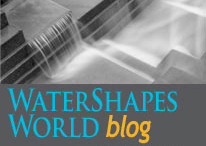Water in the Air


Do pools raise humidity? Given that moisture content of the air is the result of evaporation, the vast majority from the ocean, is it possible that areas with high numbers of pools experience more humid conditions? If so, do pools ironically compromise the outdoor experience rather than offer comfort? Eric Herman tackles those questions, with an eye toward separating fact from “suburban” myth.
By Eric Herman
There’s a popular notion here in the desert — one I’ve encountered several times — that swimming pools and golf courses raise humidity in a given area through water evaporation.
On a basic conceptual level, it’s an understandable supposition. Pools and other watershapes such as fountains, ponds, and lakes do lose water to evaporation, especially when it’s hot. And likewise, golf courses require huge amounts of water to irrigate, much of which is inevitably lost to evaporation.
Palm Springs, here in Southern California’s blistering Coachella Valley, features an abundance of high temperatures, golf courses, and pools (famously the most swimming pools per capita in the world, with approximately one pool for every six people). Many assume that these factors measurably raise the humidity. Some of my neighbors and fellow citizens will preach it as gospel as they suffer through a miasma of heat and increasing levels of airborne moisture.
Frankly, I’ve never believed it. Most of the time, this is one of the driest regions in North America, and the adage “it’s a dry heat” usually applies, although certainly not always. Critical thinking might reasonably dictate that the overall lack of humidity means that pools and golf courses do not have much of an impact, but is that true?
I have an “armchair understanding” of weather and climate, which I find a divinely interesting and complex topic. The rise and fall of moisture content in the air is actually the result of factors such as temperature, atmospheric currents and barometric pressure, as well as proximity to large bodies of water.
Here in the Coachella Valley, humidity rises during monsoon season in the summer months. We don’t get hit with monsoon storms directly here, but the nearby Sonoran Desert of Arizona does, resulting in what local meteorologists refer to as “Monsoonal Moisture,” or “Subtropical Moisture.” This year, we’ve not only experienced many record-high temperatures with numerous days above 120F, there has been unusually high humidity to go along with it, featuring soaring dew points and increased relative humidity.
Suffice it to say, the combination of heat and humidity can be miserably hot and muggy. Those conditions, among other things, prompt this idea that pools and golf courses are at least partly to blame. Having never delved into the topic, I decided to see what I could find. Not surprising, humidity is a vast topic with oceans of information at our fingertips.
In terms of the specific question about pools and golf courses, an August 2020 feature in The Washington Post cites a 1986 study by the University of Arizona, which charted humidity starting in 1973. This is a period during which Phoenix area experienced widespread expansion, including epic numbers of residential pools, elaborate resorts and lots of places to chase the little white ball. The study found that “absolute” humidity, had actually decreased during that time.
Fast forward to July, 2021, the journal, Nature Climate Change published a peer-reviewed article, “Hot Extremes have Become Drier in the United States Southwest.” Surveying dozens of sources, the analysis indicates that in arid regions, hot days have been steadily getting drier for the past 70 years, a shift that corresponds to rising global temperatures.
ASU researchers, Karen A. McKinnon, Andrew Poppick, and Isla R. Simpson write: “Here we show that specific humidity on dry days during summer (defined here as July–September) has decreased over the past seven decades in the United States Southwest, and that the greatest decreases co-occur with the hottest temperatures.”
In speaking directly to swimming pools’ possible effect on humidity, in Phoenix, retired ASU climatologist Anthony Brazel said he does not believe pools have a measurable impact. “If Phoenix was all swimming pools, then there might be a regional scale impact, but I don’t think that’s really there right now. The surface area of pools overall is probably miniscule compared to the surface of the city,” says Brazel.
Ultimately, I would argue it’s reasonable to believe that humidity is driven by forces far greater than swimming pools and golf courses. Meanwhile back here in Palm Springs, it’s 113F with only 11% relative humidity, and it is most certainly time for a swim.
